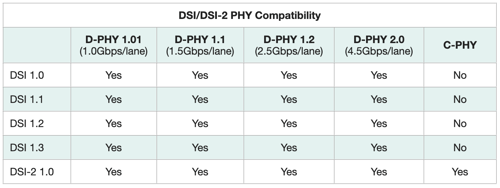MIPI DSI®
MIPI Display Serial Interface
-1.png?width=1800&height=900&name=Banner%20Images%20-%20MIPI%20(11)-1.png)
Developed by: Display Working Group
A versatile, high-speed interface for displays in smartphones, tablets, laptops, automotive and other platforms
Quick Facts
-
Fundamental Features
- High performance
- Low power
- Low EMI
-
Use Cases
- UHD resolution
- Embedded displays
- Smart meters
- Video game devices
- Smart watches
- Virtual or augmented reality Head-mounted devices
- In-sight (glass) devices
-
Physical Layer
MIPI D-PHY
Get the Specification
-
Current Version
MIPI DSI® v1.3.2 (September 2021)
Member version
-
App Notes & Conformance Test Suites
-
Previous Versions
All DSI versions are available to MIPI members on the member website (Causeway).
Overview
General Info
-
Overview
The MIPI Display Serial Interface (MIPI DSI®) defines a high-speed serial interface between a host processor and a display module. The interface enables manufacturers to integrate displays to achieve high performance, low power, and low electromagnetic interference (EMI) while reducing pin count and maintaining compatibility across different vendors. Designers can use MIPI DSI to facilitate brilliant color rendering for the most demanding imagery and video scenes and to support transmission of stereoscopic content.
MIPI DSI is developed by the MIPI Display Working Group. The latest MIPI DSI update, v1.3.2, was released in 2021.
Note: The specification is available only to MIPI Alliance members. For information about MIPI Alliance membership, visit Join MIPI.
-
Capabilities
MIPI DSI has been widely adopted. It is ubiquitous in smartphones and also being used in tablets, laptops and laptop/tablet hybrids. It is also being implemented by the automotive industry for dashboard displays and in-car infotainment systems, and used in wearables, IoT and virtual/augmented reality applications.
MIPI DSI operates on the MIPI D-PHY physical layer. It uses a command set defined in the MIPI Display Command Set (MIPI DCS). It also incorporates the Display Stream Compression (DSC) Standard from the Video Electronics Standards Association (VESA). Overall, the feature set of MIPI DSI is quite similar to that of the more recent MIPI DSI-2℠ specification, which offers support for both MIPI D-PHY℠ and MIPI C-PHY℠.
-
Diagrams & Tables
Industries








